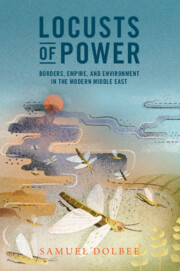Book contents
- Locusts of Power
- Reviews
- Studies in Environment and History
- Locusts of Power
- Copyright page
- Contents
- List of Figures and Maps
- Preface
- Acknowledgments
- Note on Spelling and Units of Measurement
- Introduction
- 1 Sultans of the Open Lands (1858–1890)
- 2 “Savage Swarms” (1890–1908)
- 3 “Weren’t We A Lot Like Those Creatures?” (1908–1918)
- 4 “Like Swarms of Locusts” (1918–1939)
- Conclusion
- Bibliography
- Index
2 - “Savage Swarms” (1890–1908)
Published online by Cambridge University Press: 16 June 2023
- Locusts of Power
- Reviews
- Studies in Environment and History
- Locusts of Power
- Copyright page
- Contents
- List of Figures and Maps
- Preface
- Acknowledgments
- Note on Spelling and Units of Measurement
- Introduction
- 1 Sultans of the Open Lands (1858–1890)
- 2 “Savage Swarms” (1890–1908)
- 3 “Weren’t We A Lot Like Those Creatures?” (1908–1918)
- 4 “Like Swarms of Locusts” (1918–1939)
- Conclusion
- Bibliography
- Index
Summary
Chapter 2 foregrounds locusts and the seminomadic Kurdish group known as the Millî between 1890 and 1908. In a shift from the policies of previous years, the Ottoman state created light cavalries known as the Hamidiye Brigades. Typically seen as co-opting Kurdish groups in defense against Russian invasion or Armenian rebellion, the Hamidiye also encompassed the Millî under the leadership of Ibrahim Pasha, who actually pushed south into the Jazira. The chapter traces how provincial borders became invoked alongside the environmental border of the desert in clashes between the Millî and the Shammar. All the while, locusts created conditions favorable to pastoralists. Locusts also forced people to move and, in other cases, offered a plausible justification for nomadic encroachment on the landholdings of urban notables. The chapter concludes with the death of Ibrahim Pasha, and the new political era it seemed to portend, even as locusts continued their work on the edge.
- Type
- Chapter
- Information
- Locusts of PowerBorders, Empire, and Environment in the Modern Middle East, pp. 84 - 134Publisher: Cambridge University PressPrint publication year: 2023

